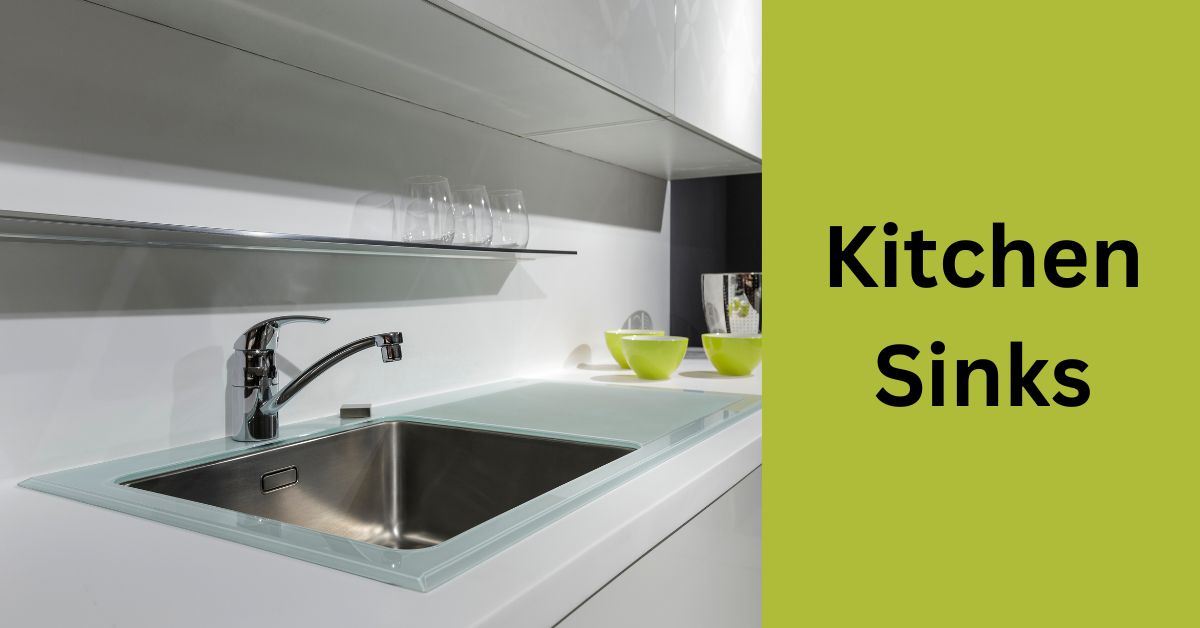Note: If you came to this post on kitchen sinks through a random search, please click on this parent page and our home page for more context.
Table of Contents
How to Select a Kitchen Sink for a Remodel
When it comes to the kitchen sink In your kitchen remodel or renovation project you have to settle a bunch of questions before determining your choice of sink.
Your choice of a kitchen sink depends on your preference for material and style, how many sinks you want, and also where and how the sink or sinks are to be installed in your new kitchen.
And then, of course, there is your budget.
Our goal here is to help you through the decision-making process.
Spoiler alert – we make no secret of our preference for the double stainless steel kitchen undermount sink.
- Related post: Kitchen Remodel Overview & Checklist
- Related post: Kitchen Layout
Best Material for the Kitchen Sink
We have counted seven different types of material used in the manufacture of kitchen sinks. Here they are with their main pros and cons:
Stainless Steel
The stainless steel sink is by far the most popular material for a kitchen sink and for good reason. It is durable and cost-effective and looks good in any style of kitchen and pairs well with granite, quartz, or wood countertops.
With minimal maintenance, stainless steel will retain its good looks for many years.
How do I choose a stainless steel sink? Stainless steel sinks are rated in thickness of material from 16 gauge to 22 gauge. The lower the gauge the better. Avoid the 22 gauge sink, which will dent easily. Go for 16 or 18-gauge. It will give you much better looks and longevity for not too much extra in price.
How do I protect my stainless steel sink? A few tips: rinse the sink and towel it dry after each use; install a stainless steel bottom grid to protect the basin from scratches; occasionally scour the sink with a soft scouring pad. And remember to scour with the grain of the steel, not across it.
Fireclay
This material gives a similar look to porcelain enamel. And while it may chip it will not rust. For some reason, it is prone to cracking under vibration and should not be used with a garbage disposal.
Copper
Copper sinks are beautiful and have antimicrobial benefits but are very expensive. Also, if you keep your copper sink polished and pristine, you will lose the antimicrobial effect.
Cast Iron Enamel
This type of sink is durable and comes in a variety of colors. It is, however, vulnerable to chipping and, therefore, rusting. It requires more maintenance than stainless steel.
Acrylic
These sinks come in a great variety of colors. They are pretty durable in regular use but are susceptible to heat damage. They are light and easy to install.
Granite/Marble/Stone Composite
These are beautiful but heavy, requiring beefed-up cabinetry. Farmhouse or apron-type sinks are made this way.
Solid Surface Resin
These are made of minerals mixed with resins. They are light and durable, easy to clean but prone to scratching if you are not careful. They are typically incorporated seamlessly into a matching countertop.
Our Recommendation
In our opinion, stainless steel is the most practical and best all-around choice because:
- It has excellent under-mount capability, which makes it great for cleanup.
- It is exceptionally tough. In this regard, the lower the gauge of steel, the better the quality.
Enameled sinks can scratch and chip. And the solid surface composite sink is prone to chipping too and not as easy to clean. Plus it is vulnerable to heat damage.
The Best Sink Style
The choice of kitchen sink style really comes down to the single or double bowl. While the original double sink with equal size bowls was made with dishwashing in mind, this function now largely belongs to the dishwasher.
However, this does not make the double sink redundant. If you have space for it, go for a double kitchen sink. Here’s why.
- Even if you have a dishwasher, you will still wash things like big pots and pans and baking sheets by hand.
- If you have a double kitchen sink the garbage disposal is always available. Not so if you are restricted to a single bowl.
- The secondary bowl can be used for food prep
So an oversized bowl for washing large items plus a smaller offset bowl for food prep is an excellent practical combination.
The single basin sink does boast the iconic Farmhouse style. We love it for its looks. But, in our opinion, it just does not beat the practical versatility of the double offset sink (aka 1.5 bowl sink or 60/40 sink for being the best all-around choice of sink.
What Is a 1.5-bowl Sink?
A 1.5-bowl sink is a twin sink where one basin is smaller than the other and set off to one side. The smaller bowl is used for food prep, and rinsing, and will have the garbage disposal attached to it. It should be around 6.5” deep to allow someone who is seated to work in it without too much stretching and reaching.
The other larger basin can be around 8” deep and will work fine for washing large items.
A popular variation on this type of sink is the 60/40 sink, where the secondary bowl is somewhat larger in proportion.
The debate about a double sink brings up a related question. If a double sink is good, why not more than just one sink? But first:
Example Double Bowl Stainless Steel Sinks on Amazon
Why Not Have Two Sinks?
Instead of just the double sink, and if you have the space and the budget, you might consider having a separate food prep sink located, say on the kitchen island.
Do You Need a Prep Sink?
Here are some reasons why a prep sink is a good idea, budget permitting::
- Your food prep can be kept away from dirty dishes, which is obviously more hygienic.
- You can also more easily segregate food prep utensils and bowls to be stored near the prep sink. This is away from the washing-up sink area and its associated detergents and cleaning equipment.
- A separate food prep sink in a food prep area makes it easier for two people to work in the kitchen without getting in each other’s way.
Prep sinks are also used as wet bar sinks.
Example Food Prep/Bar Sinks on Amazon:
Where Should the Sink Be Placed in the Kitchen?
In placing your kitchen sink, you will no doubt be constrained by the availability of plumbing and electrical and the need to have a dishwasher nearby. And you will also be considering the possibility of multiple sinks and work zones.
But here are some other things to consider when placing your kitchen sink:
What do you want to look at? Standing at the sink is pretty boring. Can you take advantage of a window view? Are you able to place a TV nearby? If you are entertaining, will you be able to see and interact with your guests?
A good place for a prep sink is on the island or peninsula. But remember you have to run plumbing to it.
Dishwasher Beside the Sink?
The only logical and economical place is to have the dishwasher adjacent to the sink. It allows you to scrape dishes into the garbage disposal, rinse them, and put them in the dishwasher without taking a step.
In addition, it allows for an easy (and therefore inexpensive) plumbing and electrical hookup.
- Related post: Dishwashers
What Side of the Sink for the Dishwasher?
Sometimes, the layout of the kitchen may not give you a choice and will force you to put the dishwasher on one side or the other. However, if you have a choice and you are right-handed, put it on the left side of the sink. If you are left-handed, put it on the right. This is the ergonomic solution
Elsewhere in this Guide, you will see that we like twin drawer-type dishwashers, one on each side of the kitchen sink.
Kitchen Sink Installation
Difference Between Topmount and Drop-in Sinks?
They are actually the same thing. A top mount (aka drop-in or self-rimming) sink has a lip around the top of the sink. This lip sits on top of the kitchen counter, which helps support the weight of the sink. The sink installer will run a bead of silicone under the lip to seal it against water spills on the counter.
Difference Between Undermount and Drop-in Sinks
While the drop-in sink has a lip that sits on top of the kitchen counter, the undermount kitchen sink has a rim that is glued or caulked to the undersurface of the countertop. The sink itself is held in place by heavy clips attached to the cabinetry.
The edges of the countertop around the cutout made for the sink are exposed and polished, which generally requires that the countertop is made of a solid material like granite or quartz.
The under-mount sink is typically installed by the countertop fabricator.
Which is Better?
Above are a composite over-mount sink to the left and a stainless steel under-mount sink to the right.
While the under-mount sink is more expensive to install, it has greater long-term benefits because it makes kitchen cleanup so much easier. And there is no lip on the countertop to trap and conceal the food debris that can harbor bacteria. In addition, the under-mount sink gives your kitchen a much more stylish look.
The Kitchen Sink and Aging in Place
A sub-theme of this site is aging-in-place, so here are some tips for accommodating the elderly at the kitchen sink.
There should be plenty of clearance around the sink to allow walkers and wheelchairs to maneuver. And there should be space beneath the sink to accommodate a chair or wheelchair. This can be achieved by having twin cabinet doors below the sink that can be opened to give knee space. An extra high toe kick in this area can take a wheelchair footrest.
Ideally, the sink should be motorized or the countertop adjustable to allow the sink to be raised and lowered.
- Related post: Kitchens for the Elderly
And don’t forget:
- a hands-free faucet with a pull-out sprayer. If hands-free is not possible, then a lever faucet mounted to the side of the sink is a good alternative.
- a soap dispenser set into or close to the sink
- an anti-scald device on the water heater to prevent burns to fragile skin from any hot water outlet in the home
- Related post: Kitchen Faucets









Leave a Reply